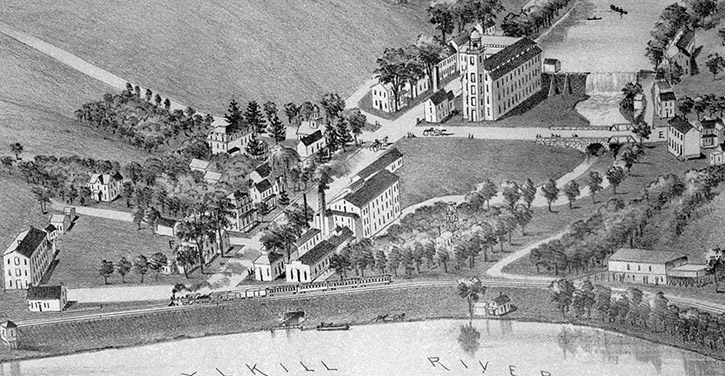|
Home : Quarterly Archives : Volume 41 |
||||
Tredyffrin Easttown Historical Society |
||||
|
Source: Summer 2004 Volume 41 Number 3, Page 74 FROM THE EDITORS Just about everyone has heard of the six months from December 19, 1777 to June 19, 1778 when George Washington"s army was at Valley Forge. But many do not know that Valley Forge was an agricultural community before this time and a mill village after that until around 1900 when the newly-formed Valley Forge Park Commission began acquiring land and determining boundaries for the future Valley Forge Park. Several features in this issue tell this story. After Mike Bertram found the remains of colliers huts and charcoal platforms while running in the woods on Mount Misery on the west side of the Park, he investigated and wrote the history presented here of the two forges that gave Valley Forge its name. He also includes information about the early mills and transportation on the Schuylkill River and the railroad in the area at this time. Sue Andrews' article provides additional perspectives on Valley Forge industry. A photo essay includes old photographs that have been digitized of some of the buildings and scenes from this period of Valley Forge's history. This issue includes the most photographs and images we have ever included at one time and we try to show how they contribute to an understanding of history. Most of the houses army officers lived in while they were at Valley Forge belonged to local families. Nancy Pusey tells how three of these houses were all owned by the same family. And "Skip" Eichner continues his earlier presentation of disease and medicine in the early days of our country. Please address all comments and questions about the Quarterly to the Editor, Joyce A. Post, 244 Vincent Road, Paoli, PA 19301. Please join us. We meet on Sundays at 2PM in the Easttown Library and Information Center, 720 First Avenue, Berwyn. The next meeting is on October 24 and will feature a presentation on segregation in the Tredyffrin Easttown schools in the 1930s. The November 28 meeting is a Christmas tea at Trinity Presbyterian Church in Berwyn and a talk about legendary Parson William Currie. We will not meet in December.
Authors retain copyright of their contributions.
TREDYFFRIN EASTTOWN HISTORY CLUB QUARTERLY VALLEY FORGE INDUSTRY
Valley Forge village and industry around 1890. Lithograph by Albert E. Downs Front cover: This enlarged view of the center of a larger lithograph of Valley Forge, Pa. by Albert E. Downs, and published in Myerstown, Pa. in 1890 by James B. Moyer, shows in great detail how the area around the present day intersection of Routes 23 and 252 in Valley Forge looked in 1890. The view is looking south, with the Schuylkill River to the north shown at the bottom and Valley Creek and its associated dam to the south shown at the top right. The left side looks to the east and the right side looks to the west. Starting at the bottom center and moving left, you can see a canal boat being pulled by either mules or horses along the river towpath, a small foot-bridge over the Creek where it empties into the River, a train on what was then the Philadelphia and Reading rail line, and, at the left margin, the buildings of the Shoddy Mill. Moving up and right across the green to where there is a small "F" is the original house of Isaac Potts, owner of the grist mill. This building, still standing and now called Washington's Headquarters, had this name as early as the time of this lithograph. It faces Mill Road which at that time extended most of the way toward the Schuylkill River. Opposite the Potts house on the west side of this road are two parallel structures and the smokestack and other buildings of the pulp and paper mill. This is the site of the earlier grist mill owned by Isaac Potts. The large mill building stands at the edge of Valley Creek. The small "E" in the road near the upper right margin marks the 1890 building of "Camp 150 PA" of the Patriotic Order of Sons of America, a national patriotic order, for whom Downs made this lithograph. It now hangs over the mantle of a fireplace in the current P.O.S.A. building, an imposing white building with tall columns on a hill overlooking Valley Creek at the top of Owen Drive to the left after you cross the Route 23 bridge. Further west along the main road, but not shown on this image, is the main village of Valley Forge. Moving left and toward the east are two end-to-end bridges on the road that is now Route 23. The first, smaller, bridge you come to crosses the raceway created by the dam. To the east of this bridge is the stone bridge crossing Valley Creek. To the south of these bridges at the right top edge is the large lake created by the dam, with boaters. The buildings on the southwest corner of the intersection are the cotton mill. The building on the southeast corner with the protective overhang is thought to be a store - perhaps a company store - and south of the store, along the road that would eventually become Route 252, is the row of stone houses where mill workers lived. Behind these buildings is Mount Joy. On the northeast corner of the intersection is a building with a cupola that was originally the house of David Potts, one of the builders of the lower forge at Valley Forge. Later it became the Victorian Washington Inn. Now a building standing at this location is called the Bake House. Joyce A. Post. |
||||
